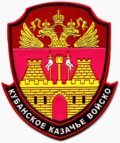
The Cossacks are a predominantly East Slavic Orthodox Christian people originating in the Pontic–Caspian steppe of eastern Ukraine and southern Russia. Historically, they were a semi-nomadic and semi-militarized people, who, while under the nominal suzerainty of various Eastern European states at the time, were allowed a great degree of self-governance in exchange for military service. Although numerous linguistic and religious groups came together to form the Cossacks, most of them coalesced and became East Slavic-speaking Orthodox Christians.

Krasnodar Krai is a federal subject of Russia, located in the North Caucasus region in Southern Russia and administratively a part of the Southern Federal District. Its administrative center is the city of Krasnodar. The third most populous federal subject, the krai had a population of 5,838,273 as of the 2021 Census.

Don Cossacks or Donians, are Cossacks who settled along the middle and lower Don. Historically, they lived within the former Don Cossack Host, which was either an independent or an autonomous democratic republic in present-day Southern Russia and parts of the Donbas region of Ukraine, from the end of the 16th century until 1918. As of 1992, by presidential decree of the Russian Federation, Cossacks can be enrolled on a special register. A number of Cossack communities have been reconstituted to further Cossack cultural traditions, including those of the Don Cossack Host. Don Cossacks have had a rich military tradition - they played an important part in the historical development of the Russian Empire and participated in most of its major wars.

Baikal Cossacks were Cossacks of the Transbaikal Cossack Host ; a Cossack host formed in 1851 in the areas beyond Lake Baikal.

Ussuri Cossack Host was a Cossack Host in Imperial Russia, located in Primorye south of Khabarovsk along the Ussuri River, the Sungari River, and around the Khanka Lake.

Kuban Cossacks, or Kubanians, are Cossacks who live in the Kuban region of Russia. Most of the Kuban Cossacks are descendants of different major groups of Cossacks who were re-settled to the western Northern Caucasus in the late 18th century. The western part of the region was settled by the Black Sea Cossack Host who were originally the Zaporozhian Cossacks of Ukraine, from 1792. The eastern and southeastern part of the host was previously administered by the Khopyour and Kuban regiments of the Caucasus Line Cossack Host and Don Cossacks, who were re-settled from the Don from 1777.

The ranks and insignia used by Russian Ground Forces are inherited from the military ranks of the Soviet Union, although the insignia and uniform has been altered slightly.

Azov Cossack Host was a Cossack host that existed on the northern shore of the Sea of Azov, between 1832 and 1862.

De-Cossackization was the Bolshevik policy of systematic repression against the Cossacks in the former Russian Empire between 1919 and 1933, especially the Don and Kuban Cossacks in Russia, aimed at the elimination of the Cossacks as a distinct collectivity by exterminating the Cossack elite, coercing all other Cossacks into compliance, and eliminating Cossack distinctness. Several scholars have categorised this as a form of genocide, whilst other historians have highly disputed this classification due to the contentious figures which range from "a few thousand to incredible claims of hundreds of thousands".

The Kuban People's Republic or Kuban National Republic was an anti-Bolshevik state during the Russian Civil War, comprising the territory of the Kuban region in Russia.
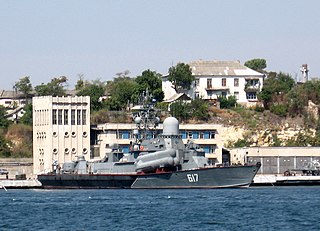
The Battle off the coast of Abkhazia was a supposed naval engagement between warships of the Russian Black Sea Fleet and Georgian patrol boats during the Russo-Georgian War.
Cossackia is a term sometimes used to refer to the traditional areas where the Cossack communities live in Russia and Ukraine, and to the lands of the Zaporizhian Host. Depending on its context, "Cossackia" may mean the ethnographic area of Cossack habitat or a proposed Cossack state independent from the Soviet Union.

Afrikan Petrovich Bogaewsky or Bogayevsky was a Russian military leader from the Don Cossack noble family of Bogaewsky. He served as a lieutenant general in the Imperial Russian Army and also served as the ataman of the Don Republic.
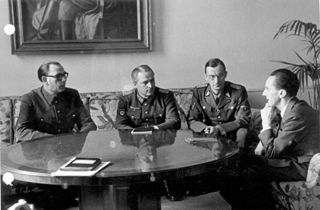
Among the approximately one million foreign volunteers and conscripts who served in the Wehrmacht during World War II were ethnic Belgians, Czechs, Dutch, Finns, Danes, French, Hungarians, Norwegians, Poles, Portuguese, Swedes, Swiss along with people from Great Britain, Ireland, Estonia, Latvia, Lithuania, and the Balkans. At least 47,000 Spaniards served in the Blue Division.
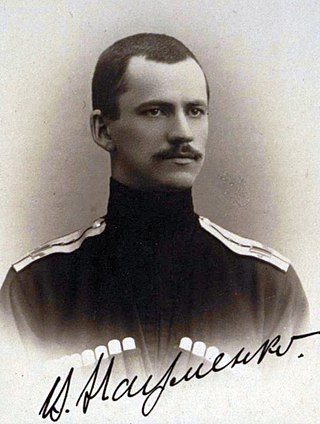
Vyacheslav Grigoryevich Naumenko was a Kuban Cossack leader and historian.
The Establishment of Soviet power in Russia was the process of establishing Soviet power throughout the territory of the former Russian Empire, with the exception of areas occupied by the troops of the Central Powers, following the seizure of power in Petrograd on October 25, 1917, and in mostly completed by the beginning of the German offensive along the entire front on February 18, 1918.
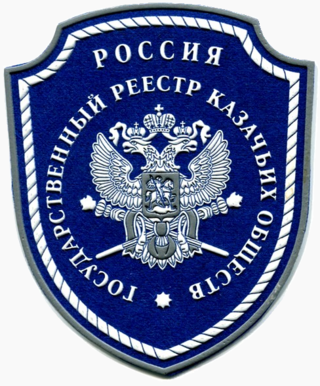
The All-Russian Cossack Society is a government sponsored Cossack advocacy organization in the Russian Federation. It is responsible for the coordination of activities between the 11 registered Cossack hosts. In particular, it works in the spheres of patriotic education and the continuing historical Cossack customs and traditions. Both registered and non-registered Cossack organizations can be part of the society. It is headed by the Society Ataman, Cossack General Vitaly Kuznetsov.
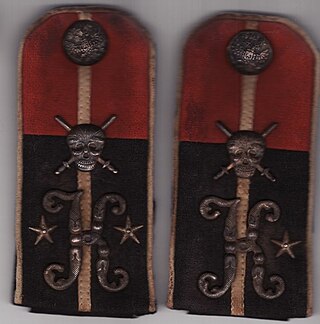
Military ranks and insignia of the White Movement (1918-1922) were based on the former Ranks and insignia of the Imperial Russian Armed Forces. However, there were new features and modifications compared to the old system:
BARS or Combat Army Reserve of the Country or simply the Combat Army Reserve is a Russian military reserve force implemented in 2015.






















